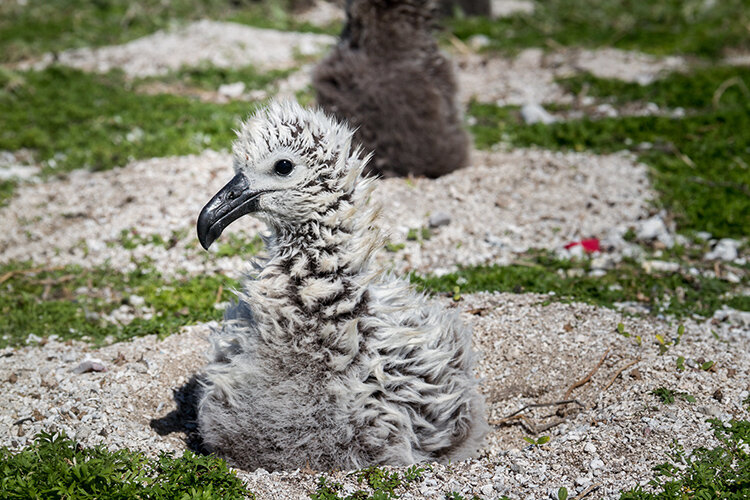Saving the Laysan Albatross of Midway Atoll
Laysan Albatross chick on Midway Atoll. © Island Conservation
Nesting habitat for 3 million seabirds
Midway Atoll is located within the Papahānaumokuākea Marine National Monument on the far northern end of the Hawaiian archipelago. Unmatched in terms of biodiversity, it is one of the oldest atoll formations in the world, providing a nesting habitat for more than 3 million seabirds annually. Midway Atoll is, in fact, the largest Laysan Albatross colony in the world. Among the three million seabirds who nest on Midway Atoll each year is Wisdom, the world’s oldest known wild bird. She has been using the same nesting site on Midway Atoll since at least 1956. Wisdom is estimated to be 68 years old and is believed to have laid nearly 40 eggs over the course of her life.
Many people associate Midway with the historic Battle of Midway, one of the most significant naval battles in modern history. It’s recognized as the pivotal moment in WWII when control of the Pacific shifted away from the Japanese Navy to American forces. Today, a different battle is being fought on Midway. The Laysan Albatross nesting on Midway Atoll are facing a fierce enemy—invasive, predatory mice.
Laysan Albatross are facing a fierce enemy
The problem began in 2015. Although mice had been present on Midway Atoll for decades, there had never been a single documented case of predation on adult albatross by mice before the 2015 hatching season. Biologists do not yet know what triggered the mice to begin preying on the largest birds on the island. Mice are omnivores, meaning they will eat any source of food they can find in their quest to survive. Pacific seabirds like the albatross evolved without any fear or defense mechanisms against mammalian predators. Their lack of defense mechanisms and dedication to their eggs leaves albatross defenseless against invasive mice. Scientists have documented an epidemic that threatens to spread through the albatross colony—mice are eating chicks and attacking adult albatrosses on their nests.
The U.S. Fish and Wildlife Service has finalized the Midway Seabird Protection Plan, an invasive mouse eradication planned for July 2020, but only if the remaining funds necessary can be secured. Our friends at Island Conservation, whose mission it is to prevent extinctions by removing invasive species from islands, will be leading the charge. It is imperative that we act quickly and decisively or we will jeopardize the health of the albatross population on Midway.
Support Island Conservation in saving the Laysan Albatross
I am personally committed to the success of Island Conservation’s Midway Albatross Campaign. We simply can’t stand by and watch this devastation. The mouse eradication operation is urgent but has been delayed until July 2020—in part because of a $750,000 funding gap. I hope you’ll consider joining me in supporting Island Conservation and their campaign to help restore Midway Atoll and remove the invasive, predatory mice that are threatening the world’s largest Laysan Albatross colony. Please visit Island Conservation’s website at noextinctions.org to learn more or to make a gift.
As a birthday gift to me this month, my wife, Shirley Metz, gave me the most unusual (and best) present that I have ever received. She adopted not one, but ten albatrosses to support the Midway Albatross Campaign. Won’t you consider contributing to this very important campaign by adopting a Midway Albatross yourself? I must say, it makes a great gift, and I am filled with hope that we can make a difference for the albatross of Midway Atoll.

